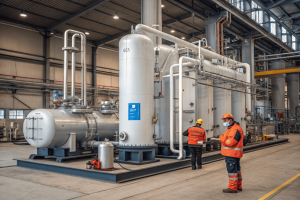What are the disadvantages of carbon capture?
•
What are the disadvantages of carbon capture?
You need to decarbonize, but the proposed solutions seem incredibly expensive and complex. The thought of a massive energy penalty and logistical nightmares for CO₂ storage is holding you back.
The main disadvantages of carbon capture are its high capital cost, the significant "energy penalty" that reduces plant efficiency, its large physical footprint, and the logistical challenges of transporting and securely storing the captured CO₂ for the long term.
As an engineer, I see the incredible potential of this technology every day. But I also see the real-world challenges my clients face. Installing a carbon capture system is not a small addition; it's like building a separate chemical processing plant right next to your existing facility. It has its own costs, its own energy needs, and its own operational complexities. Understanding these drawbacks is the first, most critical step in planning a successful and financially viable project. Let's break down the details.
What are the advantages of post combustion carbon capture?
You have an existing facility and need to reduce emissions. Building a brand new plant designed for carbon capture is not an option. You need a solution that works with what you already have.
The primary advantage of post-combustion capture is its flexibility. It can be retrofitted to existing power plants and industrial facilities without needing to fundamentally change the main combustion process. It's an end-of-pipe solution that treats flue gas after the fuel is burned.

This is the number one reason post-combustion is the most widely discussed method. I work with clients who have run their plants for decades. They can't just scrap everything and start over. Post-combustion technology, usually using amine solvents, essentially "bolts on" to the exhaust system. It lets the core of their operation—the part that makes them money—continue to run as it always has. We just add a step at the very end to clean up the flue gas before it goes into the atmosphere.
Flexibility and Proven Technology
The feasibility of retrofitting is its greatest strength, making decarbonization accessible to a huge range of existing industries.
The Retrofit Advantage
The key is that post-combustion capture separates the carbon capture process from the power generation or industrial process. This means a cement plant, a steel mill, or a power station can add this technology without a complete redesign. This drastically lowers the barrier to entry compared to other methods that would require a ground-up rebuild. It allows asset owners to extend the life of their existing infrastructure while meeting new environmental regulations.
Mature and Understood Process
The most common method, amine scrubbing, is not a new invention. It has been used for decades in the natural gas industry to remove acid gases. This means the technology is well understood, the operational risks are known, and there is a mature supply chain for the equipment and chemicals. This level of maturity provides a degree of reliability and predictability that is essential for large, capital-intensive projects.
What is the difference between pre and post combustion carbon capture?
You hear about different types of carbon capture. It's confusing to know when one method is used over another, and what the core differences in the engineering process are.
The main difference is when the CO₂ is captured. Post-combustion captures CO₂ from exhaust gases after the fuel is burned. Pre-combustion removes the carbon from the fuel before it is burned, a more complex process that creates a hydrogen-rich fuel.

I often explain this to clients with a simple analogy. Post-combustion is like filtering smoke from a campfire after it’s already burning. Pre-combustion is like processing the wood first to turn it into a clean-burning charcoal that produces no smoke. The first is an add-on, while the second requires changing the fuel itself. Both can work, but they are suited for completely different situations. Pre-combustion is typically only considered for brand new facilities designed specifically for it, like integrated gasification combined cycle (IGCC) plants.
A Head-to-Head Comparison
The choice between pre- and post-combustion capture depends entirely on the application, mainly whether it's a new build or a retrofit.
| Feature | Post-Combustion Capture | Pre-Combustion Capture |
|---|---|---|
| Timing of Capture | After fuel is burned with air. | Before the final combustion step. |
| Process | Treats low-pressure flue gas with high nitrogen content. | Gasifies fuel into "syngas" (CO and H₂), then shifts to CO₂ and H₂. |
| Gases Separated | Separates CO₂ (10-15%) from Nitrogen (~75%). | Separates concentrated CO₂ (40-60%) from Hydrogen. |
| Primary Application | Retrofitting existing power and industrial plants. | New-build plants (e.g., IGCC, hydrogen production). |
| Key Advantage | Flexibility to add to existing infrastructure. | Higher efficiency of CO₂ separation due to higher pressure and concentration. |
Post-combustion's adaptability makes it the workhorse for decarbonizing our current industrial base. Pre-combustion is a more integrated, and potentially more efficient, option for the next generation of industrial plants that are built from the ground up with capture in mind.
What are the disadvantages of complete combustion?
You've always been taught that complete combustion is the ideal. It means you are getting the most energy possible out of your fuel. But this ideal process has an unavoidable environmental consequence.
The main disadvantage of complete combustion is that it maximizes the production of carbon dioxide (CO₂). While it's efficient from an energy standpoint and avoids creating pollutants like carbon monoxide (CO), it converts every carbon atom in the fuel into an emission.

As an engineer, this is a fundamental trade-off we deal with. For decades, the goal was always complete combustion. It's the most efficient way to release thermal energy. Incomplete combustion, which produces soot and toxic carbon monoxide, was seen as a failure of the system—it's wasteful and dangerous. But in today's world, the very byproduct of that perfect efficiency, CO₂, has become the problem we now have to solve. It forces us to add another entire process, carbon capture, just to deal with the consequence of doing our primary job so well.
The Efficiency Paradox
Achieving perfect combustion solves one set of problems while creating another, larger environmental one. The goal now is to maintain that high energy efficiency while managing its inevitable byproducts.
Maximum CO₂ Production
When a hydrocarbon fuel like natural gas (CH₄) burns completely, the reaction is simple: CH₄ + 2O₂ → CO₂ + 2H₂O. All the carbon in the methane becomes carbon dioxide. This process releases the maximum amount of energy, which is why it's desirable for power generation and industrial heat. However, this direct conversion is the source of the emissions that carbon capture technologies are built to address.
Potential for NOx Emissions
Another disadvantage, particularly at high temperatures, is the formation of nitrogen oxides (NOx). The air we use for combustion is nearly 80% nitrogen. At the high temperatures needed for complete combustion, this atmospheric nitrogen can react with oxygen to form NOx, which is a potent pollutant that contributes to smog and acid rain. So even a "perfect" combustion process can create other harmful emissions that require their own separate control technologies.
Conclusion
Carbon capture's main drawbacks are its cost, energy use, and storage logistics. Post-combustion offers a flexible retrofit solution, differing from pre-combustion's pre-burn carbon removal, which avoids a key disadvantage of efficient combustion: maximum CO₂ production.
You may also be interested in:

Why is CO₂ recovery technology gaining popularity worldwide?
Why is CO₂ recovery technology gaining popularity worldwide? You see headlines about carbon capture everywhere. But you wonder if it's
Read more
How is a CO₂ recovery system designed to fit different industries?
How is a CO₂ recovery system designed to fit different industries? You're under pressure to implement a CO₂ recovery solution.
Read more
How energy-efficient are today’s CO₂ recovery technologies?
How energy-efficient are today’s CO₂ recovery technologies? You want to recover CO₂, but you fear that high electricity bills will
Read more